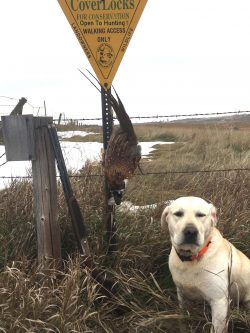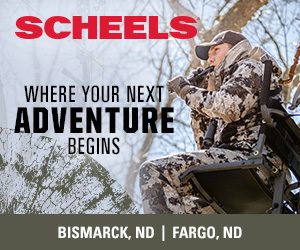
Photo: PLOTS lands provide great hunting opportunities for upland game, deer and waterfowl, and through planting and cost-sharing programs, make the process of managing marginal stretches easier and more affordable for landowners.
By: Nick Simonson
With gains of nearly 30,000 acres in the Private Land Open to Sportsmen (PLOTS) program from 2018 to 2019, the North Dakota Game & Fish Department (NDG&F) is eyeing a continued increase of quality hunting lands for sportsmen across the state heading into 2020.
Now at about 791,000 acres of private land contracted with the department for hunter access from a high of over one million acres in the mid- 2000s, NDG&F Private Lands Section Leader Kevin Kading suggests the program is poised to make the most of the opportunities currently on the landscape, benefiting both landowners and sportsmen in the coming year and long into the future.
Future Focused on Quality
“We still have our sights set on a million acres as far as an overall goal, but we don’t have a timeline; we’re not going to get excited about that as far as losing sight of quality,” Kading stated, “with all the work that goes into one PLOTS agreement, 30,000 acres last year was a big lift because a lot of those acres were new habitat, new grass plantings, five or six thousand acres of those are new grass,” he added, stressing that a lot of time and effort goes into getting all aspects, from the contract, to the planting, to the cost-share programs to be analyzed.
When the state boasted more than three million acres of private marginal lands enrolled in the Conservation Reserve Program (CRP), the process seemed almost as simple as hanging up new signs around the grasslands which landowners made available to the NDG&F for the program and ultimately to hunters. Now with significantly less land enrolled in CRP, locking down quality tracts of habitat provides more of a challenge for Kading’s team, which consists of eight private lands biologists around the state. These staffers cover multiple counties and are on the ground working with landowners finalizing agreements, developing the best seed mixes for the terrain, assessing the habitat needs for their region’s wildlife and other efforts related to the process.

“They’re the ones that hunters should be thanking,” Kading said.
In addition, there is a pair of regional supervisors at the main office in Bismarck which oversee the out-state efforts of the biologists and a mapping specialist who helps develop the annual PLOTS guide. For the dozen or so NDG&F employees in the Private Lands Section, the turn of the calendar to 2020 means revisiting agreements and working out new ones in order to get them finalized for the upcoming hunting season.
With a deadline at the end of June, the section members work to get all the information together on what lands are being added, what lands are coming out, and how the PLOTS guide will be impacted. With the documentation and mapping information in place, the field staff takes on the tasks of putting up the well-known yellow triangular signs to mark the boundaries of new parcels before the hunting seasons kick off in September.
Strong Sportsman and Landowner Support
In 2019, about $75,000 was donated to the PLOTS program by sportsmen throughout the state. Whether through the process of electing donations as part of a license purchase on the NDG&F website or donating a portion of refunded amounts from an undrawn application for big game, hunters contributed to the private land section’s bottom line. In total, since the options have been available to defer these refunds, sportsmen have contributed more than $400,000 toward the PLOTS program.
“It doesn’t surprise me,” Kading stated, “in some ways hunters have been donating to the program since it began by buying a hunting license; a portion of every hunting license, whether you’re resident or non- resident, goes towards PLOTS…to take the extra step and donate extra money on top of that just tells me they believe in the program,” he continued, adding that support drives his team’s efforts to prioritize those funds to PLOTS parcels with better quality habitat.
With over 95 percent of land in North Dakota being privately owned, the program is also popular with operators for creating fiscal and land-use options and cost-sharing initiatives. Whether it’s short-term or long-term, landowners are looking for those options through Farm Bill programs, an easement, or a sale of land for the creation of a Wildlife Management Area, PLOTS agreements also make up a big part of the mix for farmers in the Peace Garden State.
With the relative difficulty in comparison to neighboring states for the creation of public land areas such as WMAs, due to a statutory oversight and veto power granted to certain agricultural groups who sit on the review board for the transfer of agricultural lands for the creation of public hunting areas, PLOTS fits the bill for operators looking to open their lands up to the public, manage them for wildlife and find financial support through the process.
“PLOTS is one of those avenues that they can utilize at least to provide that public access and make some financial decisions with their land,” Kading said of landowner engagement with the program, adding, “it certainly is part of the landscape that is important for North Dakota with the challenges about creating public lands.”
Reasons for enrollment of lands by owners varies greatly, as each person has their own desire or mix of rationales for signing their acres up for PLOTS. One of the primary reasons for enrollment is that landowners simply want to allow hunting access without having to be bothered by people coming in to ask for permission. The financial aspect of the stipend paid to the landowner by the NDG&F is attractive in addition to the wildlife benefits that come with managing the acres for game and non-game species.
Landowners interested in enrolling for PLOTS in 2020 should visit gf.nd.gov/plots/landowner to learn more about the program and the various habitat management options available to them.

